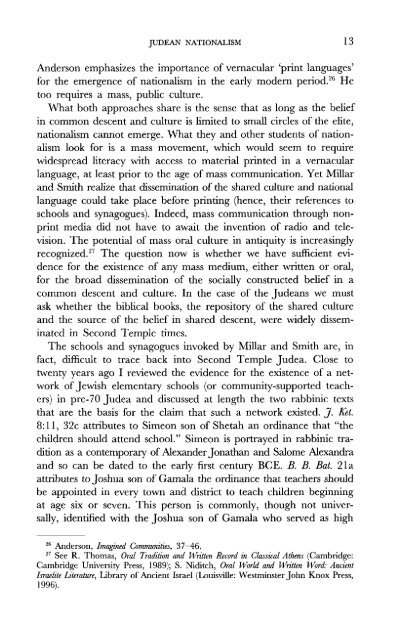historical perspectives: from the hasmoneans to bar kokhba in light ...
historical perspectives: from the hasmoneans to bar kokhba in light ...
historical perspectives: from the hasmoneans to bar kokhba in light ...
Create successful ePaper yourself
Turn your PDF publications into a flip-book with our unique Google optimized e-Paper software.
JUDEAN NATIONALISM 13<br />
Anderson emphasizes <strong>the</strong> importance of vernacular 'pr<strong>in</strong>t languages'<br />
for <strong>the</strong> emergence of nationalism <strong>in</strong> <strong>the</strong> early modern period. 26 He<br />
<strong>to</strong>o requires a mass, public culture.<br />
What both approaches share is <strong>the</strong> sense that as long as <strong>the</strong> belief<br />
<strong>in</strong> common descent and culture is limited <strong>to</strong> small circles of <strong>the</strong> elite,<br />
nationalism cannot emerge. What <strong>the</strong>y and o<strong>the</strong>r students of nationalism<br />
look for is a mass movement, which would seem <strong>to</strong> require<br />
widespread literacy with access <strong>to</strong> material pr<strong>in</strong>ted <strong>in</strong> a vernacular<br />
language, at least prior <strong>to</strong> <strong>the</strong> age of mass communication. Yet Millar<br />
and Smith realize that dissem<strong>in</strong>ation of <strong>the</strong> shared culture and national<br />
language could take place before pr<strong>in</strong>t<strong>in</strong>g (hence, <strong>the</strong>ir references <strong>to</strong><br />
schools and synagogues). Indeed, mass communication through nonpr<strong>in</strong>t<br />
media did not have <strong>to</strong> await <strong>the</strong> <strong>in</strong>vention of radio and television.<br />
The potential of mass oral culture <strong>in</strong> antiquity is <strong>in</strong>creas<strong>in</strong>gly<br />
recognized. 27 The question now is whe<strong>the</strong>r we have sufficient evidence<br />
for <strong>the</strong> existence of any mass medium, ei<strong>the</strong>r written or oral,<br />
for <strong>the</strong> broad dissem<strong>in</strong>ation of <strong>the</strong> socially constructed belief <strong>in</strong> a<br />
common descent and culture. In <strong>the</strong> case of <strong>the</strong> Judeans we must<br />
ask whe<strong>the</strong>r <strong>the</strong> biblical books, <strong>the</strong> reposi<strong>to</strong>ry of <strong>the</strong> shared culture<br />
and <strong>the</strong> source of <strong>the</strong> belief <strong>in</strong> shared descent, were widely dissem<strong>in</strong>ated<br />
<strong>in</strong> Second Temple times.<br />
The schools and synagogues <strong>in</strong>voked by Millar and Smith are, <strong>in</strong><br />
fact, difficult <strong>to</strong> trace back <strong>in</strong><strong>to</strong> Second Temple Judea. Close <strong>to</strong><br />
twenty years ago I reviewed <strong>the</strong> evidence for <strong>the</strong> existence of a network<br />
of Jewish elementary schools (or community-supported teachers)<br />
<strong>in</strong> pre-70 Judea and discussed at length <strong>the</strong> two rabb<strong>in</strong>ic texts<br />
that are <strong>the</strong> basis for <strong>the</strong> claim that such a network existed. J. Ket.<br />
8:11, 32c attributes <strong>to</strong> Simeon son of Shetah an ord<strong>in</strong>ance that "<strong>the</strong><br />
children should attend school." Simeon is portrayed <strong>in</strong> rabb<strong>in</strong>ic tradition<br />
as a contemporary of Alexander Jonathan and Salome Alexandra<br />
and so can be dated <strong>to</strong> <strong>the</strong> early first century BCE. B. B. Bat. 2la<br />
attributes <strong>to</strong> Joshua son of Gamala <strong>the</strong> ord<strong>in</strong>ance that teachers should<br />
be appo<strong>in</strong>ted <strong>in</strong> every <strong>to</strong>wn and district <strong>to</strong> teach children beg<strong>in</strong>n<strong>in</strong>g<br />
at age six or seven. This person is commonly, though not universally,<br />
identified with <strong>the</strong> Joshua son of Gamala who served as high<br />
26 Anderson, Imag<strong>in</strong>ed Communities, 37-46.<br />
27 See R. Thomas, Oral Tradition and Written Record <strong>in</strong> Classical A<strong>the</strong>ns (Cambridge:<br />
Cambridge University Press, 1989); S. Niditch, Oral World and Written Word: Ancient<br />
Israelite Literature, Library of Ancient Israel (Louisville: Westm<strong>in</strong>ster John Knox Press,<br />
1996).

















